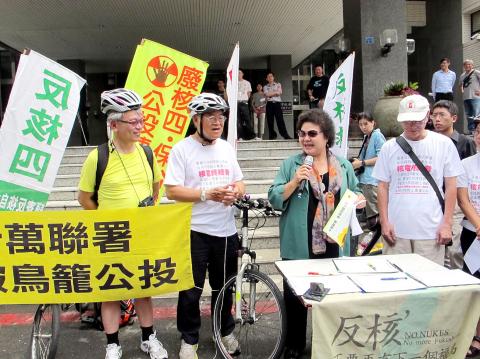|
Japanese activist
questions nuclear plant safety
FAULTY: The anti-nuclear activist said Taipower
had used outdated geological site information and the Fourth Nuclear Power
Plant¡¦s design was flawed
By Shelley Shan / Staff reporter

Greater Kaohsiung Mayor Chen Chu,
third left, welcomes anti-nuclear power protesters who are riding their bicycles
around Taiwan after they arrived in Greater Kaohisung yesterday.
Photo: CNA
Former General Motors engineer Yoichi
Kikuchi on Thursday questioned the safety of the design of Taiwan¡¦s Fourth
Nuclear Power Plant ¡X the Longmen (Àsªù) plant in New Taipei City¡¦s (·s¥_¥«) Gongliao
District (°^¼d) ¡X saying it was not as safe as Taiwan Power Co (Taipower) claimed.
The Japanese anti-nuclear power activist raised four main questions about the
nation¡¦s fourth nuclear power plant.
He said Taipower adopted outdated geological information about the site on which
the nuclear power plant is built.
The seismic coefficient, an indicator of a structure¡¦s ability to withstand an
earthquake is too low, he said.
The design of the power plant¡¦s advanced boiling-water reactor (ABWR) is flawed,
Kikuchi added.
He said that the plant¡¦s safety inspection group failed to see the real
problems.
Kikuchi arrived in Taipei earlier this week at the invitation of Green Citizen¡¦s
Action Alliance, who tried to apply on his behalf for a visit to the plant.
Taipower rejected the application, saying it was inappropriate that foreigners
join local residents informing a group of visitors to the plant.
Kikuchi said the recirculating water cooling system was installed outside the
reactor.
Because the energy produced by the reactor would cause the temperature in the
reactor to rise, the welded part of the guide tubes would gradually crack
because of metal fatigue, damage that occurs when a material is subject to
repeated pressure.
If an earthquake occured under those circumstances, the consequences would be
unimaginable, he said.
Although Taipower has decided to install a recirculating water cooling system
inside the reactor instead, he questioned if anyone would risk being exposed to
radiation to maintain the system inside the reactor.
The design of the control rods, which are mounted through the holes at the
bottom of the reactors, would cause radiation to leak if the reactor melts, he
said.
Kikuchi said that many incidents had occurred with the ABWRs that were in
operation in Japan, adding that they have yet to resume operations after being
suspended.
In response, Taipower, which runs the nation¡¦s three operating nuclear power
plants, said that moving the recirculating water cooling system inside the
reactor was not something new, adding that similar procedures have already taken
place in Europe.
It said the system¡¦s tubes are less likely to break if they are inside the
reactors.
It said that there are holes at the bottom of the reactor for control rods, but
it had ensured through multiple testing that this part of the reactor is able to
endure pressure as any other part in the reactor.
|
![]()
![]()
![]()